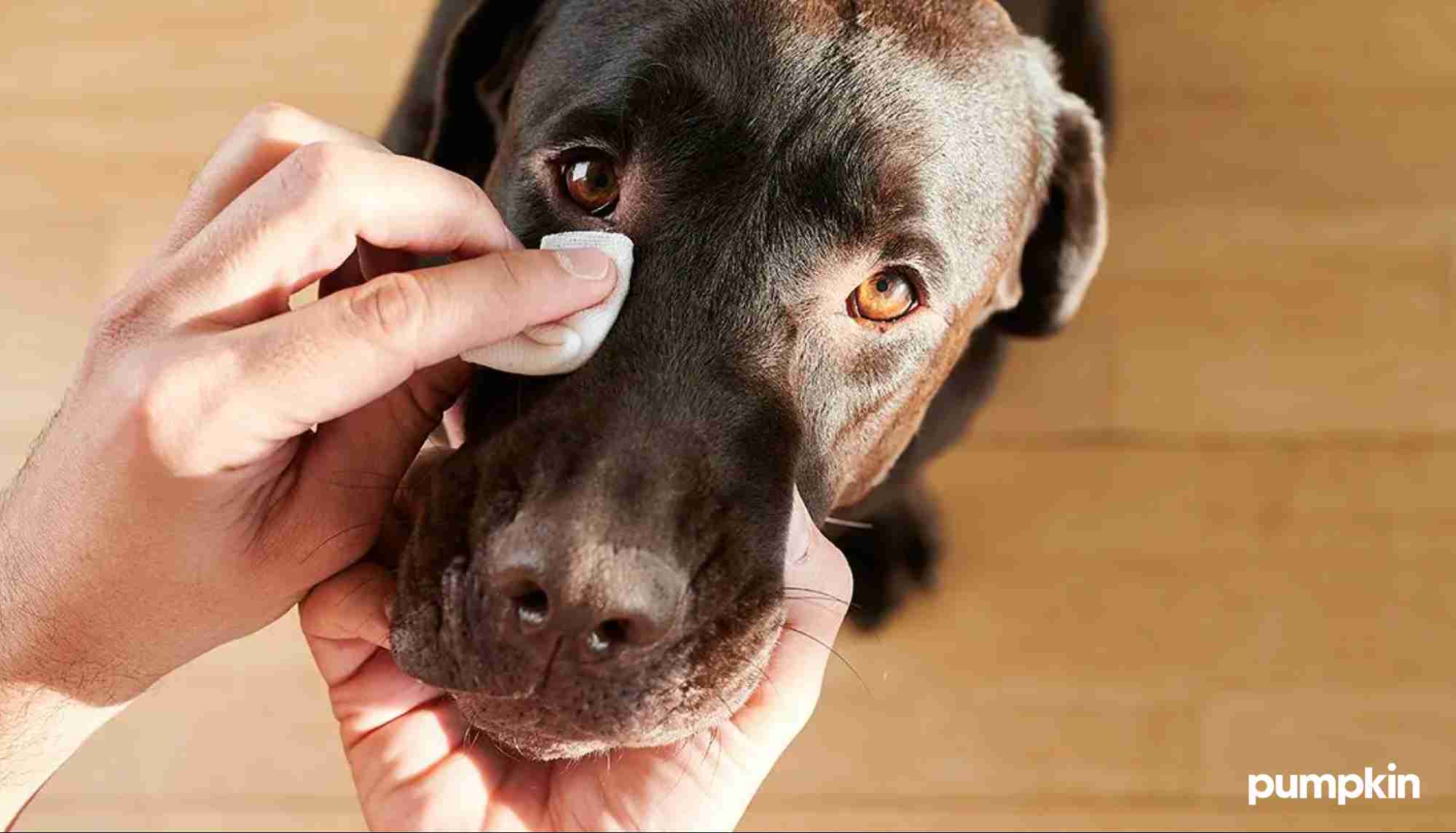Key Points
- Pink eye in dogs can be caused by allergies, viruses, and bacteria.
- If your dog has conjunctivitis, symptoms may include itchiness, swelling, and inflammation in the eye area.
- This condition is not usually life-threatening, but it will require veterinary care.
If you’ve ever had conjunctivitis, aka pink eye, you know it can come with runny eyes, inflammation, swelling, and embarrassment. That last side effect isn’t a clinical symptom, but a result of the common knowledge that pink eye can be caused when feces particles get into the eyes — yuck. (There are many other potential causes of pink eye.)
This uncomfortable condition is common in humans and enough to make us wear our sunglasses indoors.
But can dogs get pink eye too? You bet they can. Pink eye in dogs is common, and your dog can get conjunctivitis in one or both of those adorable puppy dog eyes. If you notice any unusual discharge from the eyes, or if they start pawing or rubbing their eyes on the rug or furniture, pink eye may be to blame.
What is pink eye or conjunctivitis in dogs?
Pink eye (conjunctivitis) occurs when the mucous membrane, or conjunctiva, that covers the eyeballs gets red and inflamed. The inflammation is usually caused by a bacterial or viral infection, though there are other causes.
You may also see your dog’s third eyelid when the conjunctiva is inflamed. This part of the conjunctiva is called the nictitating membrane, and it’s located in the inner corners of the eyes. Your dog’s conjunctiva can become itchy and turn bright pink or red.
Certain breeds are more likely to get pink eye, such as:
- Cocker Spaniels
- Pugs
- Poodles
- Hounds
- Bulldogs
Viral or bacterial conjunctivitis can be contagious. If your pet does have pink eye, try to keep them away from other animals until the condition improves.
Symptoms of pink eye in dogs
If your dog gets pink eye, their eyelids and eyeballs may be itchy, burning, and painful. Other telltale signs include:
- Discharge from the affected eye
- Rubbing their face on rugs, furniture, or their paws
- Squinting, excessive blinking, or holding their eyes closed
- Crusty eyelids from dried discharge, especially after sleeping
- Red, swollen mucus membranes surrounding the eyes
- Hair loss around the eye area
- Exposed third eyelid
- Swollen eyelids
- Watery eyes, tearing, or sneezing
Look for discharge if you’re worried your pup has pink eye. Cloudy white discharge is typical of allergies. Bacterial infections usually cause green or yellow eye discharge, which is common with chronic dry eye and corneal ulcers.
If you can’t see your vet straight away, use a cold compress (not frozen) on the infected eye to reduce swelling and inflammation.
Types of pink eye in dogs
There are different types of pink eye in dogs. The right treatment depends on the type of conjunctivitis they have.
Allergic conjunctivitis
Allergic conjunctivitis is common in pups predisposed to atopic dermatitis, something that affects up to 15% of dogs.
However, any pup can react to environmental allergens such as dust, pollen, perfumes, shampoos, molds, mites, smoke, and certain proteins or foods.
If you think your dog has an allergy, try to minimize their exposure. This can be as simple as regularly washing their bedding and keeping your home dust-free. Consider leaving your dog inside when mowing the lawn or on days with a high pollen count.
Viral conjunctivitis
Any virus that causes inflammation in the eyes falls into this category. The most common viral infections are canine distemper and canine herpesvirus.
Viral conjunctivitis is usually mild and resolves on its own. While anti-viral medications are available for severe cases, the best course of action is prevention with vaccination.
Bacterial conjunctivitis
Bacteria can cause dog eye infections. This type of conjunctivitis is usually secondary to an underlying medical condition, such as:
- Chronic dry eye, also known as keratoconjunctivitis sicca
- Corneal ulcerations or injuries
Other medical conditions that can cause conjunctivitis in dogs include:
- Immune-mediated diseases
- Tumors of the eyelid or conjunctiva
- Blocked tear ducts
- Injuries and trauma to the eye from foreign objects or pollutants
- Cataracts and glaucoma
- Eyelid or eyelash abnormalities
- An inability to close the eye, often secondary to facial nerve paralysis
- Parasites like roundworms or Theliza (eye worms) can live on the surface of the eye
Speak to your vet if you notice any changes to your dog’s eyes.
Having a dog insurance plan in place can help cover the cost of treatment for your pet when the unexpected happens. Learn more about how a Pumpkin Dog Insurance plan can help you save money on eligible vet bills in the future.
How is pink eye diagnosed?
When left untreated, canine conjunctivitis can lead to permanent eye damage. If your dog is showing signs of eye discomfort, it’s best to see a veterinarian.
Here’s what to expect at the appointment:
Physical examination: Your vet will do a thorough physical examination to rule out anatomical abnormalities affecting your dog’s eyes or any damage to the eye or surrounding areas.
Ophthalmic examination: A complete examination of the eye structures, including the eyelids, fur around the eyes, eyelashes, the nictating membrane, cornea, sclera, conjunctiva, anterior chamber, lens, and retina.
A tear production (Schirmer tear) test: A non-invasive test that examines your dog’s tear production.
A corneal stain test (fluorescein test): The veterinarian checks the outer layer of the eye and the cornea for scrapes and ulcerations. The veterinarian will put a yellow stain on the eye and examine it in a darkened room with a special light.
The intraocular pressure test: Used to measure the pressure in both eyes to see if the dog has glaucoma or uveitis.
Your veterinarian may also order bacterial cultures, a conjunctival scraping or biopsy, allergy testing, viral testing, ultrasound, or tear duct flushing.
If your dog has a difficult case, you may be referred to a veterinary ophthalmologist or dermatologist.
What is the treatment for canine conjunctivitis?

Your dog’s treatment plan will depend on the cause of their conjunctivitis. Here’s how to treat pink eye in dogs:
Allergic conjunctivitis: Your vet may prescribe steroid eye drops or ointments to reduce the inflammation. Alternatively, your dog may receive oral steroids and antihistamines. Your vet may recommend allergy testing, environmental changes, and food trials if they suspect your dog has a food allergy.
Bacterial conjunctivitis: Topical antibiotics and anti-inflammatory eye drops or ointment are usually prescribed.
Eyelid or eyelash abnormalities: These often require surgical correction. Eye drops and ointments may be prescribed to ease symptoms until the dog is ready for surgery.
Chronic dry eye (KCS): This condition will require eye drops for the rest of your dog’s life to provide comfort and maintain the health of their eyes.
An Elizabethan collar (a dog cone) may be recommended. This collar will stop your dog from touching their eyes while they’re healing, and reduce further irritation. With the right treatment, most dogs recover from conjunctivitis.
Does your dog have pink eye?
Pink eye is common in humans and dogs alike. Allergies, viruses, bacteria, and injuries can all cause this condition. Look for symptoms such as irritation, discharge, itchiness, and swelling around the eye area. Your dog may also paw at their swollen eyes or try to rub them on the floor or other surfaces.
When in doubt, your next step is simple: Visit the veterinarian.
FAQs
- https://www.vet.cornell.edu/departments-centers-and-institutes/riney-canine-health-center/canine-health-information/atopic-dermatitis-atopy
- https://vcahospitals.com/know-your-pet/keratoconjunctivitis-sicca-kcs-or-dry-eye-in-dogs
- https://vet.purdue.edu/hospital/small-animal/resources/immune-mediated-diseases.php
- https://vcahospitals.com/know-your-pet/eyelid-conjunctival-and-periocular-tumors




